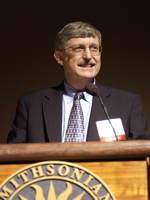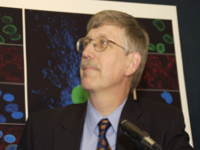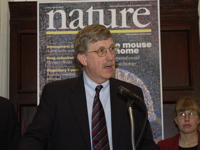 |
 |
|
Collins circa 2003, Human Genome Project symposium |
Collins circa 2003, progeria press conference |
| TH E N I H C A T A L Y S T | JU L Y – A U G U S T 2008 |
| | |
Francis Collins, the director of the National Human Genome Research Institute, stepped down on August 1 to explore writing projects and other professional opportunities. Collins served as NHGRI's director since April 1993. Widely respected, he led the Human Genome Project to its successful conclusion in 2003, and subsequently initiated and managed a wide range of projects that built upon the foundation laid by the sequencing of the human genome. Collins has appeared in over 20 issues of The NIH Catalyst (which also made its NIH debut in 1993) and agreed to an "exit" interview.
What unique roles or opportunities do you see for the NHGRI and NIH intramural programs in the area of human genetics?
There are many terrific opportunities here. Many of them relate to individual research projects, but there are also some larger collaborations underway that could be quite groundbreaking. For example, Julie Segre and Eric Green are organizing a major program in the human skin microbiome, taking advantage of the combined resources of the Clinical Center and the NIH Intramural Sequencing Center (NISC). Colleen McBride and Larry Brody have organized a fascinating program called the Multiplex Project, which is studying how 1,000 people seen at Henry Ford Hospital in Detroit react to being given information about their risks for several common diseases-a real test of the personalized medicine approach to prevention. Les Biesecker and Eric Green of NHGRI are collaborating with investigators at NHLBI in a program called ClinSeq, which is applying high- throughput sequencing to discover new and interesting genetic contributions to cardiovascular disease. And I am particularly excited about the possibility that the NIH intramural program could formalize a powerful and integrated program in therapeutics for rare and neglected diseases.
Taking advantage of the remarkable facilities of the NIH Chemical Genomics Center (NCGC), investigators with an interest in a particular disease are already provided with the ability to develop small molecule research probes for almost any target. Recent exciting examples include Gaucher's disease and schistosomiasis. What is needed now is to expand the medicinal chemistry capabilities to turn these research probes into clinical candidates, and then the Roadmap-funded RAID program can pick up the most promising compounds and take them to the next step of toxicology testing and GMP synthesis.
[Also] the Clinical Center is the perfect place to conduct Phase 0, 1 and 2 trials for these new therapeutic approaches for rare and neglected diseases. The NIH Intramural program may be the only place in the world that can do all of this within one facility, and my hope is that NIH can now push that agenda forward with great intensity.
 |
 |
|
Collins circa 2003, Human Genome Project symposium |
Collins circa 2003, progeria press conference |
One of your many strengths as NHGRI Director has been your close attention to the ethical, legal and social implications of genome research. Perhaps as advice to the next director, what challenges remain, and what successes in these realms to you see possibly coming undone without vigilance?
The ELSI [Ethical, Legal and Social Implications] program has been one of the most important experiments conducted by NHGRI, as the existence of such a program has led to the recruitment of a remarkable cohort of ethicists, lawyers, social scientists, theologians and others to focus on the potential challenges presented by the rapidly accelerating pace of genomic research. A major accomplishment has been the signing of the Genetic Information Nondiscrimination Act (GINA) by President Bush on May 21, 2008 — the culmination of 13 years of legislative effort by many dedicated experts, fueled by a foundation based on ELSI research.
But there are many challenges still remaining: to name just a few, the regulation of genetic testing, the arrival of direct to consumer marketing of genome analysis, concerns about privacy and informed consent, the issue of human enhancement, and the optimum use of intellectual property claims.
What are some of the big questions that biomedical science needs to answer? Along these lines, what kinds of joint ventures or trans-NIH initiative do you envision among the NIH ICs?
Now that we have the genome sequence, we need to figure out how it functions and how that is affected in health and disease. I counted up the major projects that NHGRI is leading to address that question (many of those in collaboration with other ICs), and there are 19 of them! They range from very basic programs such as the Encyclopedia of DNA Elements (ENCODE) to a very specific and intense approach to cancer, the Cancer Genome Atlas (joint with NCI).
Was there a big difference between starting an Institute and maintaining it?
Oh, yes. One of my biggest and most exciting tasks when I arrived in 1993 was to start the NHGRI intramural program. Many people at that time said that it would be impossible to recruit senior leaders from the outside to come to NIH and serve as Branch Chiefs. But because of the unique opportunity to start a flagship program in the rich environment of the intramural campus, it was possible to bring in phenomenal leaders like Jeff Trent, Bob Nussbaum, Jennifer Puck, Max Muenke and Eric Green. Getting strong leaders right from the beginning, and turning them loose to set up one of the most highly productive and competitive programs in human genetics in the world, has made the maintenance of the program much easier — though one can never be complacent!
 |
 |
|
Collins circa 2002, announcing completion of mouse genome |
Collins with kids at NHGRI retreat |
What do you rank as one of your (or your institute's) top achievements?
I'd have to point to the completion of all of the goals of the Human Genome Project, ahead of schedule and under budget, in April 2003. But since then, another major achievement has been the success of the HapMap project in defining the nature of human genetic variation, leading to the discovery of nearly 200 genetic variants associated with common diseases like diabetes and heart disease.
Is there anything you wanted for NIH but just couldn't quite pull off?
In order to really understand gene-environment interactions, a population-based prospective cohort study is badly needed in the U.S., with at least half a million people enrolled. With other experts, I tried to make the case for this, starting about four years ago. But other than some pilot work, this has not received the necessary momentum to get off the ground. Almost everyone agrees this project (sometimes known as the American Genes and Environment Study, or AGES) would be incredibly valuable, but the steep price tag has made it difficult to get it started.
What should NHGRI look for in your replacement? Perhaps a polar opposite, a tuneless hack afraid of engine grease?
Someone who is broadly familiar with the science of genomics, who is not afraid of taking risks, who likes working collaboratively with lots of different experts, and who has a passion for seeing basic science discoveries turned into major advances for human health.
You wrote that you may "need greater latitude than my current position allows to pursue other potential positions of service without encountering any possible conflicts of interest, whether real or perceived." Did the new conflict of interest rules play a role in your decision to leave? Is the NIH hurting itself with such rules?
As an NIH institute director, I believe it is very important not to participate in any activities that have even the slightest appearance of any conflict of interest, particularly given the current climate of Congressional scrutiny and public concern. I understand, therefore, why the current conflict of interest rules have to be quite strict for senior leaders. As I came to the decision that it was time for me to seek other opportunities to serve, I concluded that my search process would be best conducted as a private citizen. And so I will become unemployed on August 1, and will spend several months exploring other opportunities without the risk of jeopardizing myself, NHGRI or NIH.
Aside from book projects, what other adventures do you have planned? Over the years you have worked in Africa with your daughter. Will you be making more mission trips?
I will become an unpaid Special Volunteer at NIH, in order to keep my lab going and allow my talented research team in Building 50 to continue the superb work they are doing on diabetes, progeria, and asthma. Other adventures will depend on what the next calling turns out to be. And I honestly don't know the answer to that right now!
Can all the CDs from the skits at the NHGRI retreats go on eBay to the highest bidder now?
Uh, let's hope that those are hidden away somewhere, only to be revealed after I am REALLY retired. And that could be quite a while!